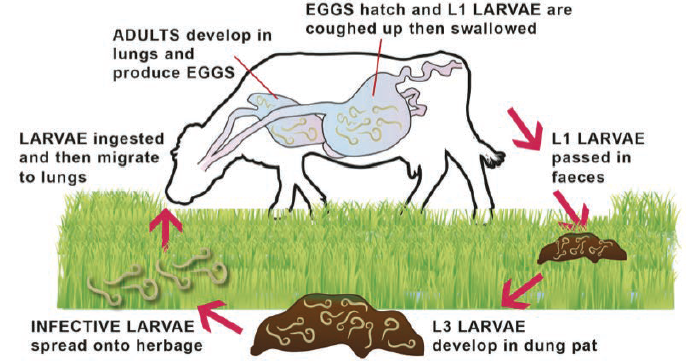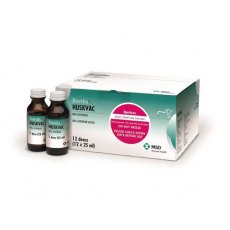Lungworm, not just a disease of youngstock
Lungworm (Dictyocaulus viviparus), also referred to as ‘husk’, largely affects first-time grazing youngstock causing reduced growth rates, increased risk of secondary bacterial pneumonia, and death in severe cases. However, the disease is not limited to youngstock and can cause significant production loss in adult cattle if they become infected.
Lifecycle
The lungworm lifecycle is similar to that of gastrointestinal worms, but there are a few key differences.

The lifecycle of lungworm. Source www.cattleparasites.org.uk
- Instead of eggs being passed in faeces, first stage larvae are passed (eggs develop into first stage larvae in the digestive tract).
- These first stage larvae develop into the infective stage – L3 (5-7 days).
- Infective larvae migrate from faeces to nearby herbage, where they can then be ingested as cattle graze.
- After ingestion, the infective larvae penetrate the lining of the intestines, migrate to the lungs where they develop into adult worms (3-4 weeks post-infection).
- Adults inhabit the main airways of the lungs and produce eggs that are coughed up and then swallowed, and the cycle repeats again.
Clinical Signs
The main clinical sign common to both youngstock and adults is bronchitis and pneumonia, which manifests as coughing. Coughing occurs when the larvae develop in the lungs and when adults begin to produce eggs. As the disease progresses, the respiratory rate increases along with weight loss, reduced feed intake and reduced milk yield in dairy cattle. In very heavy infections, the worm burden may be so great, and the clinical signs be so severe, that death occurs in the following 24-48 hours. However, some infections in adult cattle may be subtle and the first clinical sign noticed may be a reduced milk yield with subsequent coughing.
Adult Cattle Infection
Adult cattle may become infected if they have never been exposed to infective larvae as calves or if they have not had subsequent exposure in their adult lives. Exposure to the parasite allows cattle to develop immunity against it., However, this immunity requires relatively continuous, low-level exposure to remain protective. If continual exposure at grazing is not achieved - and therefore the animal’s immunity against lungworm is not boosted - they will be susceptible to reinfection.
Some adult cattle may not have immunity against lungworm because they have been regularly wormed to prevent lungworm (and gutworm) infection during the grazing period, limiting or eliminating ‘natural’ exposure to the parasite. If these cattle then graze heavily contaminated pasture and are not treated strategically with a wormer, then they will be susceptible to infection.
Diagnosis
Clinical signs and a lack of preventative measures against lungworm can indicate lungworm infection. Confirmation of infection requires a faecal sample from the affected animal(s) which is tested using a ‘Baermann technique’ that detects the first larval stages of the parasite. This is the most sensitive and specific diagnostic test in an individual animal as blood samples to detect antibodies against lungworm are only useful 4-6 weeks after lungworm infection. If death occurs, the adult lungworm can be seen in the main airways of the lungs and in the trachea without a microscope. Exposure to lungworm infection can be monitored in dairy herds by testing a bulk milk sample for antibodies.
Treatment
Treatment needs to be discussed with your vet, as the choice of wormer will depend on your farm’s set up, any other worming requirements and withdrawal times. In addition to these considerations, there are differing lengths of protection provided by different wormers which may also affect choice of produce. All available wormers are highly effective against late-stage larvae and adult lungworm and there are no reports of resistance at present.
Affected animals should be treated promptly to ensure good response to treatment and to avoid exacerbation of clinical signs from dead or dying larvae blocking the lower airways. Once treated, cattle should be moved to ‘clean’ pasture if available or housed in well-ventilated areas.
Treatment of milking cows can be difficult due to many wormers not being licensed for use in lactating dairy cattle. There are some products that are appropriate for use in dairy cattle and these should be discussed with your vet.
‘Prevention is better than cure’
This well-known saying is very appropriate for the control of lungworm infection on all cattle systems. Exposure to infective larvae is required for immunity to develop against lungworm; however, simply turning calves and adult cattle out to grass without any protection allows potential outbreaks to occur if the pastures are heavily contaminated. The immune system must be primed before exposure to high numbers of infective larvae to avoid being overwhelmed and succumbing to natural infection and therefore disease.
Vaccination using ‘Bovillis Huskvac’ produced by MSD is the best method of preventing lungworm. The vaccine is administered orally and contains live irradiated infective-stage larvae that can migrate to the lungs but cannot develop into late-stage larvae and therefore adults. By mimicking the initial stages of natural infection with a very small dose, vaccinated animals develop a strong immunity in response to future exposure. Ideally, first-time grazing animals should receive the vaccine ahead of turnout – it is important to give two doses of the vaccine four weeks apart. If adult cattle have not been vaccinated as calves and have avoided infection due to strategic worming, but succumb to infection if worming ceases, then they can be vaccinated in the same manner as first-time grazing animals.
It is important to remember that the immunity against lungworm requires low-level exposure to the infective larvae from season to season to maintain adequacy. Grazing normal pastures post-vaccination is usually sufficient; however, a single dose of the vaccine can be administered prior to turnout if exposure has not occurred.
- 28th January 2021


